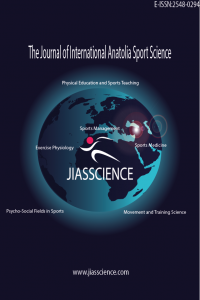ANALYZING MOTIVATION FACTORS EFFECTIVE IN PARTICIPATION WITH RE-CREATIVE EXERCISE PURPOSES IN FITNESS AND CROSSFIT CENTERS
Rekreasyon, Boş Zaman, Güdülenme, Fitness, CrossFit
FİTNESS VE CROSSFİT MERKEZLERİNE REKREATİF EGZERSİZ AMAÇLI KATILIMDA ETKİLİ OLAN MOTİVASYON FAKTÖRLERİNİN İNCELENMESİ
Recreation, Leisure time, Motivation, Fitness, Crossfit,
___
- Altıntaş, A., Aşçı, F. H. and Özdemir, B. T. (2007). Benlik sunumunun cinsiyet ve egzersiz davranışı parametrelerine göre incelenmesi Hacettepe Üniversitesi Spor Bilimleri Dergisi. 18(2).
- Ames, C. (1992). Classrooms: Goals, structures and student motivation. Journal of Education Psychology.
- Annesi, J.J. (2004). Relationship of Perceived Health and Appearance Improvement, and Self- Motivation, With Adherence to Exercise in Previously Sedentary Women, European Journal of Sport Science, vol. 4, issue 2: 5.
- Ardahan, F. (2013). ‘‘Bireyleri Rekreatif Spor Etkinliklerine Motive Eden Faktörlerin REMM Ölçeğini Kullanarak Çeşitli Demografik Değişkenlere Göre İncelenmesi: Antalya Örneği’’, Pamukkale Journal of Sciences, vol 4, no. 2.
- Brunet, J. and Sabiston, C.M. (2009). Social physique anxiety and physical activity: A self- determination theory Perspective, Psychology of Sport and Exercise, 10.
- Caglar, E., Canlan, Y., Demir, M., (2009). ‘‘Recreational Exercise Motives of Adolescents and Young Adults’’, Journal of Human Kinetics Volume 22.
- Crandall, R. (1980). Motivation For Leisure, Journal of Leisure Research, 12(1).
- Daley, A. and Duda, J. L. (2006). Self-determination, stage of readiness to change for exercise, and frequency of physical activity in young people. European Journal of Sport Science, 6.
- Deci, E. L. (1975). Intrinsic motivation. New York: Plenum Press.
- Deci, E. L. and Ryan, R. M. (2002). Handbook of self-determination research. Rochester, NY: University of Rochester Press.
- Deci, E. L., and Ryan, R. M. (1985). Intrinsic motivation and self-determination in human behavior, New York, NY: Plenum Press.
- Dweck, C. (1986). Motivational processes affectinin learning. American Psychologist.
- Ersöz, G. (2011). Egzersize Katılım Güdüsü, Sürekli Performans Duygu Durumu ve Sosyal Fizik Kaygı Düzeyinin Egzersiz Davranış Basamağına ve Fiziksel Aktivite Düzeyine Göre İrdelenmesi, Ege Üniversitesi, Sağlık Bilimleri Enstitüsü, Sporda Psiko Sosyal Alanlar Anabilim Dalı, Doktora Tezi.
- Fisher, J., Sales, A., Carlson, L., Steele, J., (2016). A Comparison of the motivational factors between crossfit participants and other resistance exercise modalities; A Plot Study, The Journal of Sports Medicine And Physical Fitness.
- Frederick, C. M. and Ryan, R. M. (1993). Differences in motivation for sport and exercise and their relations with participation and mental health. Journal of Sport Behaviour, 16.
- Frederick, C.M., Morrison, C. And Manning, T. (1996). Motivation to participate exercise affect and outcome behaviors toward physical activity, Perceptual and Motor Skills, 82.
- Fuzhong, L. (1999). The Exercise motivation scale: Its multifaced structure and construct validity. Journal of Applied Sport Psychology. 11: 1.
- Gill, D.L., Williams, L., Dowd, D.A., Beaudoin, C.M. and Martin, J.J. (1996). Competitive orientations and motives of adult sport and exercise participants. Journal of Sport Behavior, 19
- Ibrahim, H., Cordes, K.A., (2002). Outdoor Reaction, Enrichment For a Lifetime. Second Edition, Sagamore Publishing, II.
- Kır, İ. (2007). Yükseköğretim Gençliğinin Boş Zaman Etkinlikleri, KSÜ Örneği Fırat Üniversitesi Sosyal Bilimler Dergisi, 17 (2).
- Koruç, P. (2015). Does Exercising For a While Changes The Motivation of Exercise Participation, International Journal of Science Culture and Sport, 3.
- Landry, J.B. and Solmon, M.A. (2004). African American women's self-determination across the Stages of Change for Exercise. Journal of Sport and Exercise Psychology, 26.
- Levy, J. (1979). Motivation For Leisure: An Intereactionist Approach. In H. Ibrahim and R.
- Crandall (Eds.), Leisure: A Psychological approach. Los Alamitos, CA: Hwong Publishing.
- Lippa, Daniel J., (2011). The Effect of Gender on Fitness Motivational Factors: An examination of St. John Fisher Collage Undergraduate Students, Sport Management Undergraduate.
- Nicholls, J. (1989). The competitive ethos and demogratic education, MA: Harvard University Press, Cambridge
- Nicholls, J. G., Robert, G. C. (Ed.). (1992). The general and the specific in the development and expression of achievement motivation, Motivation in Sport Exercise, Human Kinetics Books
- Roberts, G. (1993). Motivation in sport: Understanding and enhancing the motivation and achivement of children. In R. N. Singer, M. Murphy, ve C. K. Tennant (Eds.), Handbook of research on sport psychology. New York: Macmillan.
- Ryan, R.M., Frederick, C.M., Lepes, D., Rubio, N. and Sheldon, K.M. (1997). Intrinsic motivation and exercise adherence. International Journal of Sport Psychology, 28.
- Sibley A.B. Bergman M.S., (2017). What keeps athletes in the gym? Goals, psychological needs, and motivation of CrossFit™ participants, International Journal of Sport and Exercise Psychology.
- Şahin, H. (1999). Kuşak Değişimi, Radikal Gazetesi, 25/09/1999.
- Tiryaki, Ş. (2000). Spor Psikolojisi: Kavramlar, Kuramlar ve Uygulama. Eylül Kitap ve Yayınevi, Ankara.
- Toros, F.Z., (2001). Elit Sporcuların Güdüsel Yönelimleri: Voleybolcular Üzerine Bir Araştırma, Mersin Üniversitesi, Sağlık Bilimleri Enstitüsü, Beden Eğitimi ve Spor Anabilim dalı, Yüksek Lisans Tezi, Mersin.
- Willis, J. D. and Campbell, L. F. (1992). Exercise psychology. Champaign, IL: Human Kinetics.
- Wilson, P. M, Rodgers, W.M, Hall, C.R. and Gammage, K.L. (2003). Do autonomous exercise regulations underpin different types of exercise imagery? Journal of Applied Sport Psychology, 15.
- Wilson, P.M. and Rodgers, W.M. (2002). The relationship between exercise motives and physical self- esteem in female exercise participants: An application of self-determination theory. Journal of Applied Biobehavioral Research, 7.
- Yetin, G. (2014). Boş Zaman İlgileniminin Boş Zaman Tatmini Ve Sadakati Üzerine Etkisi: Eskişekir’deki Fitness Merkezlerine Araştırma, Yüksek Lisans Tezi, Anadolu Üniversitesi, Sağlık Bilimleri Enstitüsü, Beden Eğitimi ve Spor Anabilim Dalı.
- Yayın Aralığı: Yılda 3 Sayı
- Yayıncı: Alparslan İNCE
Selahattin AKPINAR, Öznur AKPINAR
SPOR YAPAN LİSE ÖĞRENCİLERİNİN ÖFKE DÜZEYLERİNİN BAZI DEĞİŞKENLERE OLAN ETKİSİNİN İNCELENMESİ
MESLEK YÜKSEKOKULUNDA ÖĞRENİM GÖREN ÖĞRENCİLERİN SOSYAL BECERİ DÜZEYLERİNİN İNCELENMESİ
Selahattin AKPINAR, Öznur AKPINAR
ÖĞRENCİLERİN KARAR VERME DÜZEYLERİ İLE SÜREKLİ ÖFKE VE ÖFKE İFADE TARZLARININ BELİRLENMESİ
Veysel TEMEL, Sefa Şahan BİROL, Selahattin AKPINAR, Kazım NAS
